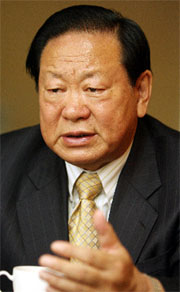Korea’s Saemaeul spirit inspires China

Hu Fuguo
The 70-year-old civil society leader said he hopes to learn from the success of Korea’s Saemaeul (New Community) Movement of the 1970s. The movement launched by President Park Chung Hee, was designed to modernize rural South Korea’s economy. Most notably, it spread orange-tiled houses throughout the country to replace the straw-thatched homes.
“Although led by the government, the Saemaeul Movement achieved great success because civilians voluntarily took part,” Hu said in an interview at a hotel in central Seoul. “The movement is a valuable legacy that China can take as a benchmark, because we are focusing on stepping up the development of agricultural villages.”
The Fuping Development Institute is, in fact, led by the State Council of the People’s Republic of China. Most of the work it does is similar to that of the 30-year-old Saemaeul Movement.
Hu, also a member of the National Committee of the Chinese People’s Political Consultative Conference, a ministerial position, was invited here by Korea’s National Council of the Saemaeul Movement.
Taking trips around North Gyeongsang and Jeju Island to observe how the movement has affected and continues to affect those areas, he said, “Hasn’t the Korean people’s striving to overcome poverty based on the Saemaeul spirit actually served as a milestone for the developed society that we see now? China needs to study that spirit and experience.”
Q. What was your impression of Korea’s economy and society overall?
A. I felt that the country is well equipped with infrastructure, including roads. Fostering outstanding human resources that have contributed to Korea’s economic progress seems to have been a success. Also, spurring progress in the science and technology sectors has added balance to the national economy.
After looking around the places where the Saemaeul Movement took place, what are your thoughts?
I visited the house where President Park Chung Hee was born in Gumi, North Gyeongsang, and there I had an opportunity to see several pictures of him.
Particularly noticeable was a picture of Park spending time with villagers in agricultural fields and another of the first lady, Yook Young-su, donating blood. They gave me the impression that Park had complete expertise in poverty issues. And I was somewhat touched by Yook’s picture.
The Saemaeul Movement received huge coverage in China last year and a number of Chinese government officials visited Korea to learn about it. But some Koreans are starting to wonder if the interest has faded a little lately. What do you think?
It is true that the boom has somewhat subsided recently. But taking a brief look around Korea does little to provide true learning about the movement. We need more practical cooperation. When I return to China, I plan to report what I saw and learned to the Chinese government.
Do you have specific plans to implement anything the Saemaeul Movement has inspired?
The midwestern area of China is in dire need of help. The mountainous geography, without much farmland, has hampered development, increasing the gap with the eastern area.
We need to pioneer the area in tandem with the China Western Development Program pushed by the government. I would like to adapt the know-how of the Saemaeul Movement in Shanxi, my home province. I will invite the governor of North Gyeongsang to show him development efforts in China. I am also willing to form partnerships with some Korean companies for developing small-sized farm machinery that is necessary for our mountainous western areas.
What interested you the most in Korea?
The bonsai park in Jeju, in particular, grabbed my attention. The park was transformed from wasteland by Sung Beom-young and I have heard it is one of the most positive results of the Saemaeul Movement. Indeed, the movement brought a remarkable change and I was so moved by what I saw that I left a piece of calligraphy, which reads, “The scenery is really beautiful, but the spirit that has fostered it seems even more precious.”
For rural communities to become rich, they need a pioneering spirit. And I felt a strong spirit there that was struggling to beat poverty.
What are the realities in China's farm villages?
As is widely known, the country has launched a large-scale development project designed to lift it out of its less-developed status. An income gap between urban areas and rural villages exists in most countries of the world, but the gap is especially severe in China. In terms of income, people who work in Chinese cities earn 3.25 times more than their rural counterparts. China’s government leaders, including President Hu Jintao, have immense interest in advancing China’s rural development.
What will be the Fuping Development Institute’s biggest focus?
Although the western area of China is less developed, it has a lot of natural resources. Injecting capital for development is a huge task.
The Chinese government also wants to foster smart people to spearhead progress. Attracting technologies and funds from overseas is also on its agenda.
By Yoo Kwang-jong JoongAng Ilbo [spring@joongang.co.kr]










with the Korea JoongAng Daily
To write comments, please log in to one of the accounts.
Standards Board Policy (0/250자)